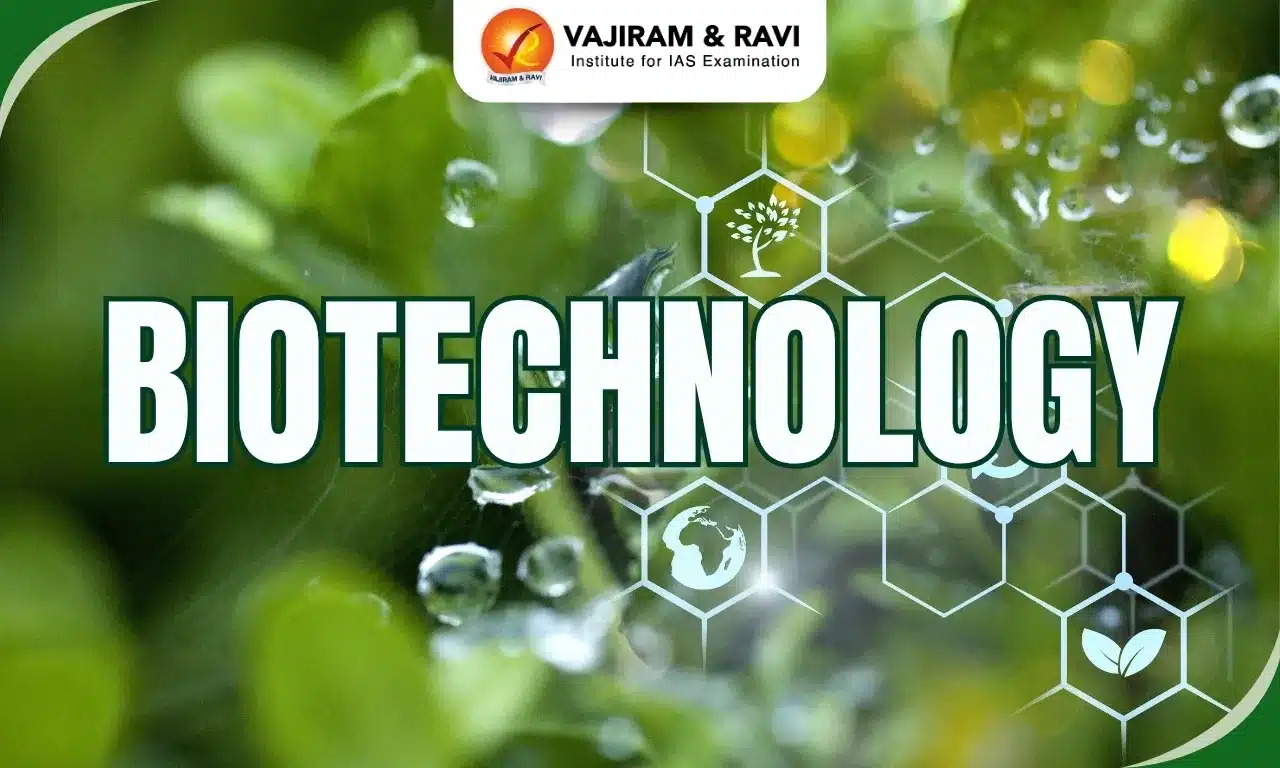Biotechnology is the application of living organisms or their parts to make technological advances and utilise those technologies in various fields. The modern era of biotechnology started with the discovery of the DNA structure as well as the development of genetic engineering techniques and the polymerase chain reaction. Biotechnology has many applications, especially in medicine and agriculture including therapeutics, diagnostics, and genetically modified crops, etc.
In India, biotechnology is entering a new era of growth as it is one of the key enablers for driving the bio-economy of the country, which has grown to more than $137 billion in 2022 from $35.5 billion in 2014.
Methods in Biotechnology
The outstanding advances in biotechnology have been underpinned by the development and application of a range of biotechnological methods.
Genetic Engineering
Genetic engineering is the process of altering an organism’s DNA using laboratory-based technologies. Recombinant DNA Technology and the Polymerase chain reaction are common methods of gene cloning.
- Recombinant DNA Technology: The steps involved in the RDT are as follows:
- Identification and isolation of genes of interest from a host organism: Restriction endonuclease cuts the target sequence of these genes.
- Insertion of the gene of interest into a vector: Again Restriction endonuclease is used to cut the specific sequence in the vector (plasmids) that matches with the sequence of the gene of interest.
- Gene cloning: The recombinant DNA (plasmid plus foreign gene) is then transferred to a suitable host which is kept to grow on a nutrient medium. The host (bacteria) then expresses the gene, by producing proteins.
- PCR: Unlike RDT, which is a cloning within a living cell, PCR replicates DNA in vitro (outside the cell). It amplifies DNA into millions to billions of copies in no time.
- It involves using short DNA fragments (artificial) called primers, to select a segment of the genome to be amplified.
- Then, Taq polymerase enzyme is used to amplify that segment in multiple cycles.
- PCR is used for the diagnosis of infectious diseases.
RNA Interference (RNAi)
RNAi is a natural defence mechanism of plants and other eukaryotic cells in which small pieces of RNA shut down protein translation by binding with the messenger RNAs that code for those proteins.
- RNAi is specifically designed to silence or deactivate genes.
- Leveraging RNAi technology to silence genes has become useful for investigating gene functions, knocking down genes in diseases, and even developing pest-resistant plants.
Tissue culture
Tissue culture is a biological research method that involves the growth of tissues or cells (plants or animals) in an artificial medium separate from the parent organism. In Plant Tissue Culture, fragments of plant tissues are transferred to an artificial environment where they grow into a full plant, due to the property of totipotency in plants.
- Plant Tissue culture has provided a way to propagate and genetically improve commercially valuable plants.
- It has been used to study characteristics of the growth, metabolism, reproduction, physiology, and nutritional necessities of plants under controlled circumstances.
- Tissue culture has permitted significant biological discoveries, including the identification of infections, enzyme deficiencies, and chromosomal anomalies, as well as the classification of cancers and the development and testing of medications and vaccines.
Bioinformatics
Bioinformatics is a subfield of biology concerned with the acquisition, storage, analysis, and transmission of biological data.
- This interdisciplinary science harnesses mathematics, computer science, physics and biology to develop software tools and methods to understand large and complex biological data.
- High-throughput data-generating experiments, including genomic sequence determinations and measurements of gene expression patterns, are used in Bioinformatics.
- The potential applications of these biological data are in drug discovery and development.
Applications of Biotechnology
Biotechnology is applied in various fields at small as well as industrial scales for the betterment of humans. Some of these applications are:
- Medicinal Biotechnology (Red Biotechnology): Biotechnology is applied in health care for diagnosis as well as treatment of diseases.
- Gene therapy: It is a method that employs genetics to treat, prevent, or cure an illness. It works by replacing a defective or missing gene in a patient’s cells with a healthier version.
- CAR T cell therapy: CAR T cell therapy is a kind of cancer immunotherapy treatment in which immune cells called T cells are genetically modified in a lab so they can more effectively identify and eliminate cancer cells.
- Genome sequencing: It refers to sequencing the entire genome of an organism. Genomic sequencing is used for the diagnosis of diseases as well as identifying therapeutic targets of the diseases.
- For example, sequencing of the COVID-19 virus was extremely useful for the development of its vaccines.
- Therapeutic proteins: Therapeutic proteins are medicines that are genetically engineered versions of naturally occurring human proteins. These proteins are extensively used in the treatment of cancer, HIV, and other diseases.
- Examples: Insulin (Humulin), Monoclonal antibodies etc.
- Industrial biotechnology (White biotechnology): Biotechnological processing makes use of enzymes and microorganisms to create products that are useful in a variety of industries, to produce chemicals, materials and fuels.
- The food and beverage industry uses S. cerevisiae (yeast).
- Microbial enzymes are used in washing detergents, food processing, cosmetics etc.
- Energy: In the energy industry, biofuels sourced from plant materials such as corn stalks and grass are developed as renewable fuel alternatives to reduce the carbon footprints of fossil fuel production.
- For example: The two most common types of biofuels in use today are bioethanol and biodiesel.
- Agricultural Biotechnology (Green biotechnology): Biotechnology gives farmers tools to make production more cost-effective and manageable.
- For example, genetically modified (GM) crops like BT Cotton have increased the productivity of crops.
- Environmental biotechnology: It uses biological processes to address environmental issues, including pollution control and renewable energy generation.
- Applications include genetic engineering, bioremediation, biopesticides, biosensors, and biofuel development, which aim to protect and restore the natural environment.
- Animal biotechnology: Biotechnology has helped to create many beneficial genetically modified animals.
- The first transgenic animal was the Dolly sheep.
Biotechnology in India
The Indian biotechnology sector is one of the country’s fastest-growing sectors and it is expected to play an important role in shaping the country’s rapidly developing economy.
- Bioeconomy: It is the economic activity driven by research and innovation in biotechnology and life sciences, and enabled by technological advances in engineering as well as in information sciences.
- Potential: India’s Bio-Economy is on its way to achieving the USD 150 bn target by 2025 and over 300 billion by 2030.
- India is one of the top 12 biotechnology destinations in the world, and the third largest in Asia Pacific.
- Biotechnology is the technology of tomorrow and can leverage the wealth of India’s bioresources, its unique biodiversity, its 7,500 km-long coastline, and vast agricultural residues.
- Biotechnology is a trending career option among youth, due to increased attention to tools like Genome editing, Synthetic technology, Microbial bioresources, enzyme and metabolic engineering, etc.
- Bio Startups: Because of the growing enabling ecosystem, the number of biotech startups in the country has increased from 50 to over 6,756 in the last ten years.
- The government aims to increase the number of biotech startups to 10,000+ by 2025.
- Subsectors of Biotechnology in India: According to the revised India Bio Economy Report 2023, India’s bioeconomy sector stands at $137 billion, contributing 4% to the national GDP and employing over 2 million people.
| Bio-Industrials |
– It includes products/ chemicals produced using recombinant DNA technology, such as industrial chemicals (industrial enzymes, acids, industrial biotechnology, etc.), biofuels, biogas, bio-based plastics, etc. – The enzymes have applications in the alcoholic beverages sector, baking, dairy, starch industry, washing detergent, as well as feed enzymes for shrimp, poultry, and laundry. – It is a relatively new and emerging subsector. – Market size: $58.97 bn – Percentage share of total bioeconomy: 43% |
| Biopharma or Biomedical |
– It includes medical products and services such as pharmaceuticals, devices, lab-grown organoids, diagnostic reagents and tests. – Key areas: Cancer immunotherapy, Gene editing, Regenerative medicine, Precision medicine, Biologics, Biosimilars, etc. – India is one of the world’s largest suppliers of low-cost medications and vaccines. – Market size: $49.79 bn – Percentage share: 36% |
| Bio-agriculture |
– It includes the production of GM crops and animals, precision agriculture technologies and bio-based products. – Focus areas: Biopesticides, biostimulants, biofertilizers, and BT cotton. – India is one of the world’s leading producers of BT-Cotton and has the fifth-largest area of organic agriculture land. – Market size: $11.47 bn – Percentage share: 8% |
| Bio Research and BioIT (BioServices) |
– It includes Clinical research and trials, Contract research, Drug discovery services, Biotechnology-related software and databases, equipment and devices, Bioscience patent lawyers and services, etc. – Market size: $9.28 bn – Percentage share: 7% |
| Covid Economy |
– it includes COVID-19 vaccines, testing, and related services. – Market size: $7.66 bn – Percentage share: 6% |
- Top contributing states(in billion dollars) in India’s bioeconomy:
Institutional Facilities for Biotechnology in India
- National Biotechnology Board (NBTB): In 1982, a National Biotechnology Board (NBTB) was constituted by the Government to strengthen indigenous capabilities in this newly emerging discipline.
- Department of Biotechnology (DBT): In 1986, DBT was set up which acts as a nodal agency supporting research and its applications in the Life Sciences and promotes & accelerates the pace of development and large-scale use of biotechnology in the country.
- DBT also supports Research and Development innovations and manufacturing in advanced Biofuels as well as ‘Waste to Energy’ technologies.
- National Centre for Microbial Resource (NCMR): NCMR was established to conserve India’s vast microbial diversity and explore its biotechnological potential for industrial and health applications.
- Indian Biological Data Centre: The IBDC is India’s first National repository for life science data, established at the Regional Centre of Biotechnology (RCB), an autonomous institute of DBT.
- IBDC adheres to the spirit of data sharing based on the FAIR (Findable, Accessible, Interoperable, and Reusable) principles.
Government Initiatives for Biotechnology in India
The Indian Government’s increased focus on the country’s biotechnology industry over the past decade. Some of the initiatives taken by the Government to further promote the sector are as follows:
- National Biopharma Mission: It is a collaborative mission between industry and academia to accelerate biopharmaceutical development in the country.
- Innovate in India (i3) programme: The government launched the Innovate in India (i3) programme as part of this Mission to create an enabling ecosystem to foster entrepreneurship and indigenous manufacturing in the sector.
- The mission will be implemented by the Biotechnology Industry Research Assistance Council (BIRAC).
- Biotech KISAN: DBT launched a Biotech Krishi Innovation Science Application Network (Biotech KISAN) in 2017.
- Its goal is to bring science laboratories and farmers together to develop and apply innovative solutions and technologies at the farm level.
- Atal Jai Anusandhan Biotech Mission: It was implemented by DBT and the purpose of this mission is to address the challenges of maternal and child health, antimicrobial resistance, vaccines for infectious disease, food and nutrition, and clean technologies.
- One Health Consortium: In 2021, DBT established a ‘One Health’ consortium to survey important bacterial, viral, and parasitic infections of zoonotic and transboundary pathogens in the country.
- Biotechnology Industry Research Assistance Council (BIRAC): It was established by DBT and is aimed at strengthening and empowering emerging biotechnology enterprises to undertake strategic research and innovation.
- Biotech Parks: The DBT establishes biotechnology parks and incubators across the country to help translate research into products and services by providing the necessary infrastructure support.
- These biotechnology parks offer facilities to scientists, and SMEs for technology incubation, technology demonstration, and pilot plant studies to accelerate the commercial development of biotechnology.
- Startup Landscape: For the first time, the biotech sector in India registered more than 1,000 new start-ups in a single calendar year in FY22. BIRAC funding has helped more than 1,000 startups.
Challenges associated with Biotechnology
Despite the boom in the biotech industry, there are some grave challenges faced by this domain.
- Ownership and equitable access: The ownership of biomaterials is fundamental to many new technologies. However, the patent system, which protects ownership rights in new biotechnologies, can also prevent many people from benefiting, particularly in developing countries.
- Ethical concerns: Biotechnology can produce unanticipated consequences that cause harm or dehumanise people.
- For example, complementary DNA (cDNA) is a genetically designed entity that can be patented. Obtaining such DNA and altered DNA sequences that can be sold for profit raises numerous ethical concerns about human life.
- Field of uncertainty: Emerging applications of biotechnology such as new genomic techniques may give rise to new uncertainties and uncertain risks.
- Even in the early days of recombinant DNA technology, it was acknowledged that there were inherent hazards in comprehending biological mechanisms, because increased understanding may be utilised to inflict harm.
- Security threats: Recent breakthroughs in synthetic biology, a technology that may be used in laboratories to artificially produce organisms, have raised concerns about the possibility of biological weapons development.
- Impact on Environment: Concerns about potential negative environmental and ecosystem function results of agricultural biotechnology include pesticide use modifications, effects on non-target species, development of pest and virus-resistant crops and impact on wild species as well as pollinators. Additional text to be added here.
Last updated on July, 2025
→ UPSC Notification 2025 was released on 22nd January 2025.
→ UPSC Prelims Result 2025 is out now for the CSE held on 25 May 2025.
→ UPSC Prelims Question Paper 2025 and Unofficial Prelims Answer Key 2025 are available now.
→ UPSC Calendar 2026 is released on 15th May, 2025.
→ The UPSC Vacancy 2025 were released 1129, out of which 979 were for UPSC CSE and remaining 150 are for UPSC IFoS.
→ UPSC Mains 2025 will be conducted on 22nd August 2025.
→ UPSC Prelims 2026 will be conducted on 24th May, 2026 & UPSC Mains 2026 will be conducted on 21st August 2026.
→ The UPSC Selection Process is of 3 stages-Prelims, Mains and Interview.
→ UPSC Result 2024 is released with latest UPSC Marksheet 2024. Check Now!
→ UPSC Toppers List 2024 is released now. Shakti Dubey is UPSC AIR 1 2024 Topper.
→ Also check Best IAS Coaching in Delhi
Biotechnology FAQs
Q1. What is Biotechnology?+
Q2. What are the segments of biotechnology in India?+
Q3. What are the achievements of India in the biotechnology sector?+
Q4. What are the benefits of Biotechnology?+
Q5. What is Red Biotechnology?What is Red Biotechnology?+
Tags: biotechnology quest















